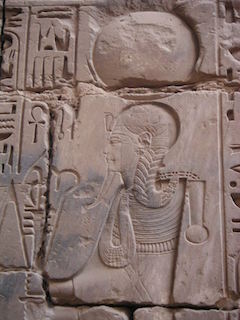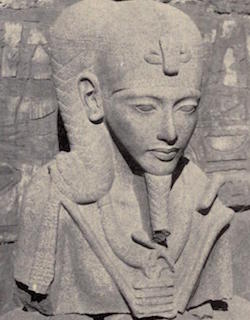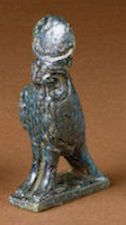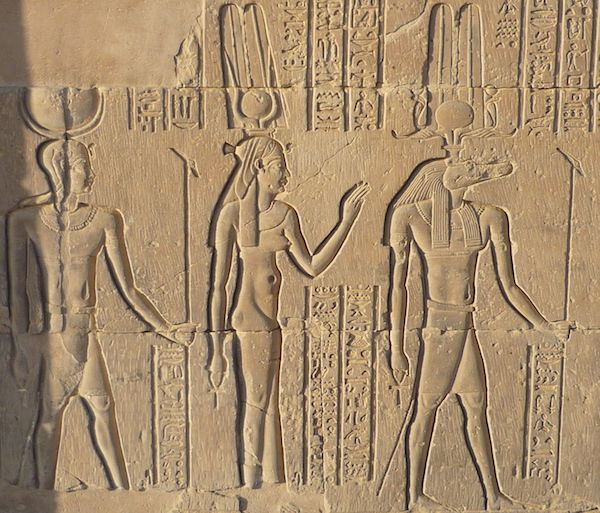 (Khons, Chons, Khensu) was a god of the moon and time. His cult center was at Thebes where he was part of a triad with Amun and Mut. He was one of the companions of Thoth (who was also associated with the moon and the measurement of time).
(Khons, Chons, Khensu) was a god of the moon and time. His cult center was at Thebes where he was part of a triad with Amun and Mut. He was one of the companions of Thoth (who was also associated with the moon and the measurement of time).
It was thought that Khonsu could influence the fertility of both the people and their livestock, and one myth (recorded on the walls of the Ptolemaic temple of Khonsu at Karnak) gives him a prominent role in the creation of the universe. He was also revered as a god of healing, as is recorded in the story of the “Princess of Bekheten”. It was said that he personally healed the pharaoh Ptolemy IV (who took the epithet “beloved of Khonsu who protects the king and drives away evil spirits” in thanks for the god’s help). He was also thought to extend his protection to the common people. As a result, many Egyptians were named after him.


Khonsu also had a darker side. During the early part of Egyptian history, he seems to have been considered to be a violent and dangerous god. He appears in the “Cannibal hymn” (part of the Pyramid Texts) as a blood-thirsty deity who helps the deceased king to catch and eat the other gods and the Coffin Texts describe him as “Khonsu who lives on hearts”. Yet, by the New Kingdom he was worshipped primarily as the gentle and compassionate son of Amun and Mut.
There has been some dispute regarding the meaning of his name. Some scholars have suggested that it represented the royal placenta (transliterated as h-nisw), but it is now generally held that it was derived from the word “khenes” (hns) meaning “to cross” or “to travel” (referring to his journey across the sky). However, he was also known by the more specific names; “Khonsu nefer hotep” (in Thebes) was described as the “lord of Ma’at“, an epithet he shared with Ptah.
When there was a new moon he was known as the “mighty bull” and during the full moon he was associated with a neutered bull. This god not only ruled the month, but was also supposed to possess absolute power over the evil spirits that infested earth, air, sea, and sky, and made themselves hostile to man attacking his body under the forms of pains, sickness, and diseases, and produced decay, and madness, and death. He it was, moreover, who made plants to grow, and fruit to ripen, and animals to conceive, and to men and women he was the god of love.
As “Khensu-pa-khart” he was the personification of the light of the crescent moon. He was also thought to help women conceive children and help the livestock to breed successfully. This aspect of the god also has an association with fresh air, and hence the god Shu. “Khonsu pa-khered” (“Khonsu the Child”) was described as the “first great son of Amun“, the son of the goddess Nubt, and an aspect of the god Ra. Like Ra-Horakhty he was thought to be a child in the morning and an old man in the evening. He was also characterised as, a youth at the beginning of the year, who cometh as a child after he had become infirm, and who reneweth his births like Disk.

Thus Khensu-pa-khart was both the spring sun, and the spring moon, and also the moon at the beginning of each month, in fact, the symbol of the renewed light of the sun and moon, and the source of generation and reproduction. In these aspects he could be linked to Horus, Ra, or Min. He was also known as “Khonsu pa-ir-sekher” (“Khonsu the provider” -Chespisichis to the Greeks) and “Khonsu heseb-ahau” (“Khonsu, decider of the life span”).




The Great Temple of Khonsu was built in the precinct of the temple of Karnak. It was begun by Ramesses III, in the New Kingdom but expanded by a number of later rulers. There were three shrines dedicated to specific aspects of the god; “The Temple of Khensu”, “The Temple of Khensu in Thebes, Nefer-hetep” and “The Temple of Khensu, who works his plans in Thebes”. Other forms of the god were probably worshipped in the main portion of the temple as aspects of the moon god.
Different aspects of this god could actually converse with each other! For example, the Bentresh Stela (created in the 4th century BC but claiming to record a statement of Ramesses II) describes how Khonsu approaches Khonsu pa-ir-sekher, a manifestation of himself in order to free a foreign princess from a hostile spirit.
Khonsu was also associated with a number of other gods. In Khumnu (Hermopolis) he was called “Khonsu-Djehuti” associating him with Thoth. While in Thebes, Khonsu was associated with Ra, Shu, Min, and Horus. During the later period Osiris and Khonsu were known as the two bull and represented the sun and the moon respectively.

Although firmly associated with Amun and Mut at Thebes at Kom Ombo Khonsu was considered to be the son of Sobek and Hathor (again linking him to Horus) and in Edfu he was considered to be the son of Osiris and known as “the son of the leg” (the leg being the part of the dead king’s body which was thought to have been found in that nome).
He was usually depicted as a young mummiform man in the posture of a mummy. In his role as the young son of Amun he generally wears the sidelock of youth and the curved beard of the gods. He often wears a full lunar disc resting in a crescent moon as a headdress and carries a crook and flail in his hands (linking him with the pharaoh and Osiris). Occasionally, he bears a staff topped by the Was (representing power) or the Djed (representing stability). He generally wears a loose necklace with a crescent-shaped pectoral and a counterpoise in the shape of an inverted key-hole. In his mummiform aspect he looks so similar to Ptah that the only way to tell them apart is to check his necklace, as the counterpoise worn by Ptah is a different shape.
Khonsu could also be depicted as a falcon-headed man, but unlike Horus or Ra his headdress is sometimes topped by a lunar, not solar symbol. Like Thoth he was associated with the baboon, but was only rarely depicted in this form.
During the later period he may be depicted on plaques as fully human or in his falcon-headed form, together with his parents Amun and Mut. He may also be depicted standing on the back of a crocodile, like Horus. As “Khensu, the chronographer” he wears the solar disk on his head and holds a stylus in his right hand. Khonsu was also a great lover of games, especially senet. He was also frequently recorded playing a game of senet against Thoth.
Khonshu in Moon Knight
The god referred to in Moon Knight is called Khonshu rather than Khonsu, but there are certain notable similarities. Like Khonsu, Khonshu (Moon Knight) wears mummy wrappings, a crescent moon on his head and has the head of a falcon (or rather the skull of a falcon).

He is the antagonist of Ammit (who herself is similar to but not exactly the same as the Egyptian Ammit), but it is not totally clear whether he is a force for Maat (order) or chaos.
Khonshu clearly has healing and restorative powers (like Khonsu) but his avatar does not seem to be an entirely willing participant and Khonshu does not seem to be entirely benevolent.
Khonshu perhaps draws more from the terrifying Pyramid Texts version of Khonsu, and less from the gentle healer he later came to be worshipped as. It remains to be seen whether his character will turn out to be the hero or the villain of the story.
Bibliography
- Cruz-Uribe, E. (1994) ‘The Khonsu Cosmogony’ Journal of the American Research Center in Egypt 31:169-189.
- Goodenough, Simon (1997) Egyptian Mythology
- Lesko, Barbara S (1999) The Great Goddesses of Egypt
- Pinch, Geraldine (2002) Handbook Egyptian Mythology
- Redford Donald B (2002) Ancient Gods Speak
- Ritner, Robert K. and Edward, Frank W. (2009) The Libyan Anarchy: Inscriptions from Egypt’s Third Intermediate Period
- Watterson, Barbara (1996) Gods of Ancient Egypt
- Wilkinson, Richard H. (2003) The Complete Gods and Goddesses of Ancient Egypt
Copyright J Hill 2010